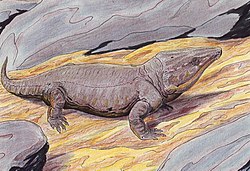Eureptilia
| Eureptilians | |
|---|---|

| |
| Labidosaurikos meachami, an early eureptilian of the family Captorhinidae | |
| Scientific classification | |
| Domain: | Eukaryota |
| Kingdom: | Animalia |
| Phylum: | Chordata |
| Class: | Reptilia |
| Clade: | Eureptilia Olson, 1947 |
| Subgroups | |
|
†Brouffia | |
Eureptilia ("true reptiles") is one of the two major clades of the Sauropsida, the other being Parareptilia. Eureptilia includes not only all Diapsids, but also a number of primitive Permo-Carboniferous forms previously classified under the Anapsida, in the old (no longer recognised) order "Cotylosauria".
Primitive were all small, superficially lizard-like forms, that probably scurried through the Paleozoic undergrowth in search of insects. The diapsids are the only eureptilian clade to continue beyond the Permian Period. Eureptilia is characterized by the skull having greatly reduced supraoccipital, tabular, and supratemporal bones that are no longer in contact with the postorbital.
Classification
Eureptilia was defined as a stem-based clade, specifically, the most inclusive clade containing Captorhinus aguti and Petrolacosaurus kansensis but not Procolophon trigoniceps, by Tsuji and Müller (2009).[1] The cladogram here was modified after Muller and Reisz (2006):[2]
| Reptilia |
| ||||||
References
- ^ Benton, M. J., Donoghue, P. C., Asher, R. J., Friedman, M., Near, T. J., & Vinther, J. (2015). "Constraints on the timescale of animal evolutionary history." Palaeontologia Electronica, 18.1.1FC; 1-106; palaeo-electronica.org/content/fc-1
- ^ Muller, J. and Reisz, R.R. (2006). "The phylogeny of early eureptiles: Comparing parsimony and Bayesian approaches in the investigation of a basal fossil clade." Systematic Biology, 55(3):503-511. doi:10.1080/10635150600755396
External links
- Eureptilia examples of some Permian species
- Eureptilia





